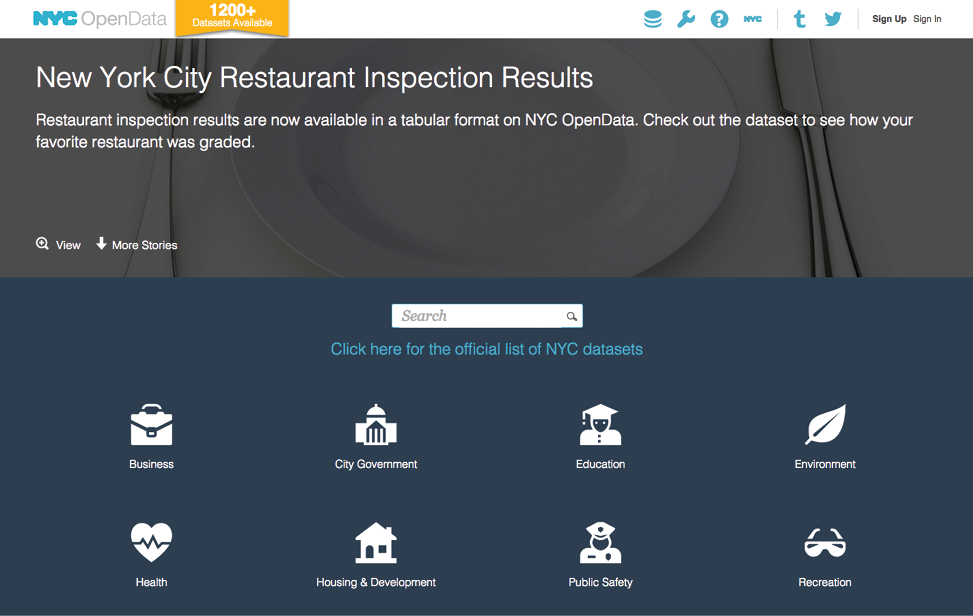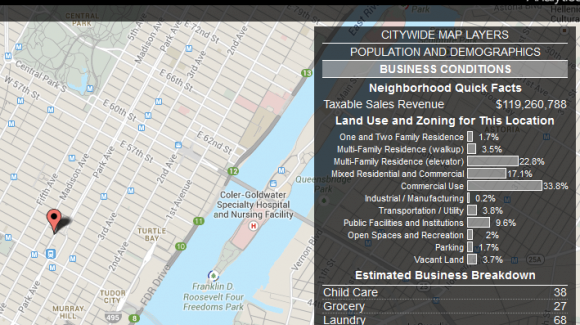The Global Impact of Open Data
United States' New York City Business Atlas
Leveling the Playing Field
by Andrew Young, David Sangokoya and Stefaan Verhulst*
Reference
2 Verhulst, Stefaan and David Sangokoya. “Data Collaboratives: Exchanging Data to Improve People’s Lives,” Medium, April 22, 2015. https://medium.com/@sverhulst/data-collaboratives-exchanging-data-to-improve-people-s-lives-d0fcfc1bdd9a.
3 "Open-air Computers," The Economist, October 27, 2012. Accessed July 14, 2015. http://www.economist.com/news/special-report/21564998-cities-are-turning-vast-data-factories-open-air-computers.
4 Exec. Order No. 306, 3 C.F.R. (2013), http://www.nyc.gov/html/om/pdf/eo/eo_306.pdf.
5 Flowers, Michael. “NYC by the Numbers Annual Report.” New York City Government. December 2013. http://www.nyc.gov/html/analytics/downloads/pdf/annual_report_2013.pdf.
6 Yasin, Rutrell. “How analytics is making NYC’s streets and buildings safer.” GCN, October 4, 2013. http://gcn.com/articles/2013/10/04/gcn-award-nyc-databridge.aspx.
7 “Open Data for All” New York City Government. 2015. http://www1.nyc.gov/assets/home/downloads/pdf/reports/2015/NYC-Open-Data-Plan-2015.pdf
9 Flowers, Michael. “NYC by the Numbers Annual Report.” New York City Government. December 2013. http://www.nyc.gov/html/analytics/downloads/pdf/annual_report_2013.pdf.
10 “NYC MODA Presentation Federal Summit.” New York City: NYC Analytics, February 2015. http://lnwprogram.org/sites/default/files/NYC_MODA_Presentation_Federal_Summit.pdf
11 Flowers, Michael. “NYC by the Numbers Annual Report.” New York City Government. December 2013. http://www.nyc.gov/html/analytics/downloads/pdf/annual_report_2013.pdf.
12 GovLab interview with Lindsay Mollineaux, Director of Analytics, Mayor’s Office of Data Analytics, New York City, July 2, 2015.
13 Flowers, Michael. “NYC by the Numbers Annual Report.” New York City Government. December 2013. http://www.nyc.gov/html/analytics/downloads/pdf/annual_report_2013.pdf.
14 GovLab interview with Mike Flowers, former Chief Analytics Officer, Mayor’s Office of Data Analytics, New York City, August 14, 2015.
15 GovLab interview with Mike Flowers, former Chief Analytics Officer, Mayor’s Office of Data Analytics, New York City, August 14, 2015.
16 GovLab interview with Mike Flowers, former Chief Analytics Officer, Mayor’s Office of Data Analytics, New York City, August 14, 2015.
17 In a separate initiative, MODA is collaborating with the New York City Small Business Services “to reduce the regulatory burden on small businesses in New York City” by sending “trained client managers to neighborhoods across the five boroughs to provide business owners with targeted education informed by data showing the specific needs in a given neighborhood – including top violations, areas of noncompliance, new business growth data, 311 complaints, and more.” “Small Business Services Launches Proactive Education and Outreach Efforts to Help Ease Regulatory Burden on New York City Small Businesses.” New York City Small Business Services. May 27, 2015. http://www.nyc.gov/html/sbs/html/pr/2015_05_27_SB1.shtml
18 Schweidel, D. A. Profiting from the data economy: Understanding the roles of consumers, innovators, and regulators in a data-driven world (Upper Saddle River, NJ: Pearson Education).
19 Furman, Phyllis. “Map this! New city tech tool lets small businesses compete with the big guys by dishing data.” New York Daily News. December 16, 2013. http://www.nydailynews.com/new-york/map-new-city-tech-tool-lets-small-businesses-compete-big-guys-dishing-data-article-1.1559044
20 GovLab interview with Florent Peyre, Chief Operating Officer and Co-Founder, Placemeter, August 19, 2015.
21 GovLab interview with Florent Peyre, Chief Operating Officer and Co-Founder, Placemeter, August 19, 2015.
22 "Platform - How It Works." Placemeter. https://www.placemeter.com/platform
23 “Privacy by Design.” Placemeter. http://www.placemeter.com/privacy
24 “NYC MODA Presentation Federal Summit.” New York City: NYC Analytics, February 2015. http://lnwprogram.org/sites/default/files/NYC_MODA_Presentation_Federal_Summit.pdf
25 GovLab interview with Mike Flowers, former Chief Analytics Officer, Mayor’s Office of Data Analytics, New York City, August 14, 2015.
26 GovLab interview with Lindsay Mollineaux, Director of Analytics, Mayor’s Office of Data Analytics, New York City, July 2, 2015.
27 GovLab interview with Lindsay Mollineaux, Director of Analytics, Mayor’s Office of Data Analytics, New York City, July 2, 2015.
28 GovLab interview with Lindsay Mollineaux, Director of Analytics, Mayor’s Office of Data Analytics, New York City, July 2, 2015.
29 GovLab interview with Mike Flowers, former Chief Analytics Officer, Mayor’s Office of Data Analytics, New York City, August 14, 2015.
30 GovLab interview with Mike Flowers, former Chief Analytics Officer, Mayor’s Office of Data Analytics, New York City, August 14, 2015.
31 Neubauer, Miranda. “With Business Atlas, NYC Analytics Office Looks to 2014.” TechPresident. January 2, 2014. http://techpresident.com/news/24635/business-atlas-nyc-analytics-office-looks-2014
32 Krasny, Jill. “NYC Data Tool Gives Small Business an Edge.” Inc. December 27, 2013. http://www.inc.com/jill-krasny/nyc-business-atlas-helps-small-businesses.html
33 “Towards Data Driven Cities? Meet up with Chief Data Officers.” Proceedings of La Fabrique De La Cite, Paris. March 23, 2015. http://www.lafabriquedelacite.com/fabrique-de-la-cite/data.nsf/FDD3CB2E8CEA41D2C1257E0F00324482/$file/actes_cdo_02062015_def_web.pdf.
34 New York City Department of Small Business Services. “Starting a Business Improvement District: A Step-by-Step Guide.” Nyc.gov. 2003. http://www.nyc.gov/html/sbs/downloads/pdf/bid_guide_complete.pdf.
35 “Towards Data Driven Cities? Meet up with Chief Data Officers.” Proceedings of La Fabrique De La Cite, Paris. March 23, 2015. http://www.lafabriquedelacite.com/fabrique-de-la-cite/data.nsf/FDD3CB2E8CEA41D2C1257E0F00324482/$file/actes_cdo_02062015_def_web.pdf.
36 GovLab interview with Mike Flowers, former Chief Analytics Officer, Mayor’s Office of Data Analytics, New York City, August 14, 2015.
37 “FireCast: Leveraging Big Data for Mitigating Fire Risks.” The Innovation Enterprise. January 22, 2014. https://ieondemand.com/divisions/big-data/events/4/presentations/firecast-leveraging-big-data-for-mitigating-fire-risks#sthash.FidXBzgc.dpuf.
38 Yasin, Rutrell. “How analytics is making NYC’s streets and buildings safer.” GCN, October 4, 2013. http://gcn.com/articles/2013/10/04/gcn-award-nyc-databridge.aspx.
39 Flowers, Michael. “NYC by the Numbers Annual Report.” New York City Government. December 2013. http://www.nyc.gov/html/analytics/downloads/pdf/annual_report_2013.pdf.
41 Coepland, Eddie. “Big Data in the Big Apple.” Capital City Foundation. 2015. http://capitalcityfoundation.london/big-data-in-the-big-apple-web-version/.
42 Flowers, Mike and Lauren Talbot. “Building a Gov Data Skunkworks.” Code for America. February 18, 2014. http://www.codeforamerica.org/peer-network-training/02-18-2014/.
43 GovLab interview with Mike Flowers, former Chief Analytics Officer, Mayor’s Office of Data Analytics, New York City, August 14, 2015.
44 GovLab interview with Mike Flowers, former Chief Analytics Officer, Mayor’s Office of Data Analytics, New York City, August 14, 2015.
45 GovLab interview with Lindsay Mollineaux, Director of Analytics, Mayor’s Office of Data Analytics, New York City, July 2, 2015.
46 GovLab interview with Mike Flowers, former Chief Analytics Officer, Mayor’s Office of Data Analytics, New York City, August 14, 2015.
47 Flowers, Michael. “NYC by the Numbers Annual Report.” New York City Government. December 2013. http://www.nyc.gov/html/analytics/downloads/pdf/annual_report_2013.pdf.
48 Flowers, Michael. “NYC by the Numbers Annual Report.” New York City Government. December 2013. http://www.nyc.gov/html/analytics/downloads/pdf/annual_report_2013.pdf.
49 Flowers, Michael. “NYC by the Numbers Annual Report.” New York City Government. December 2013. http://www.nyc.gov/html/analytics/downloads/pdf/annual_report_2013.pdf.
50 GovLab interview with Florent Peyre, Chief Operating Officer and Co-Founder, Placemeter, August 19, 2015.
51 “Open Data for All” New York City Government. 2015. http://www1.nyc.gov/assets/home/downloads/pdf/reports/2015/NYC-Open-Data-Plan-2015.pdf




